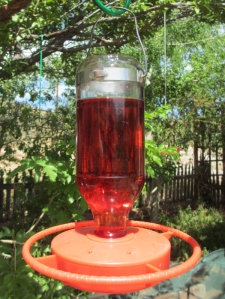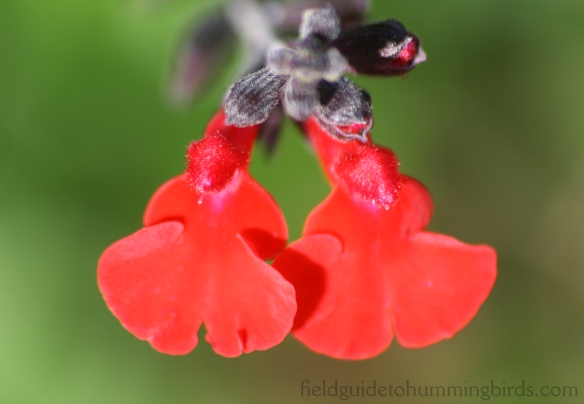Some recent searches on the theme of what to put in hummingbird feeders:
“can you make hummingbird food with brown sugar”
Please don’t try this. Brown sugar contains molasses, which is rich in iron, and excess iron can be deadly to hummingbirds. Use that brown sugar to make some delicious chocolate chunk blondies or pineapple upside-down cake instead.
“can you make hummingbird nectar out of organic cane sugar?”
“organic evaporated cane juice hummingbird nectar”
Again, the light beige color of semi-refined sugars, including organic sugar and “evaporated cane juice,”* indicates the presence of potentially toxic iron (though at a lower concentration than in brown sugar). Until some company comes out with a fully refined white organic sugar, it’s safest to stick with non-organic white sugar. GMO sugar is a non-issue, but some people report that hummingbirds prefer pure cane sugar to either beet sugar or blends of the two (which are usually just labeled “sugar”).
“should you feed hummingbirds high fructose corn syrup”
No. HFCS is made up of two simple sugars, glucose and fructose, which are components of sucrose, the most abundant sugar in the nectars of hummingbird-pollinated flowers. Hummingbirds get all the glucose and fructose they need by digesting sucrose, and HFCS has a greater likelihood of contamination during the manufacturing process.
“how much orange extract to put in hummingbird nectar”
NONE. That product appealingly labeled “Pure Orange Extract” is 79% alcohol plus a little water and orange oil squeezed from discarded orange rinds, not the good part of the fruit. It’s not nutritious, it won’t attract the birds, and it may harm them. At best it will probably attract bees. Seriously, don’t do this.
“can i use vanilla in hummingbird feeders”
*sigh* “Pure” vanilla extract also contains alcohol—not as much its orange counterpart, but still the equivalent of 80-proof booze. Hummingbirds don’t pollinate vanilla orchids, nor do they need flavored sugar water to encourage them to visit feeders. Again, you’re more likely to increase your bee problems, which won’t be popular with your hummingbird clientele.
“is koolaid safe for humming birds”
NO. Kool-Aid contains petroleum-based synthetic dyes, artificial flavorings, preservatives, and other things that are at best useless and at worst harmful to hummingbirds. A glass of Kool-Aid every now and then won’t kill you or me, but what do you think would happen if we ate 100+ packages of the dry mix every day? That’s the equivalent of a hummingbird’s daily intake, minus the water and sugar (the only ingredients in prepared Kool-Aid that hummingbirds actually do need).

This feeder’s contents are colored with organic tart cherry juice, not synthetic dyes. The birds prefer plain sugar water, and the juice makes the solution spoil faster, so I don’t encourage this.
“can u add [fruit juice] to hummingbird food”
You can, but again you’re asking for trouble, including premature spoilage and bees. If you’re thinking of substituting fruit juice for dye in plain sugar water, the least problematical kind of juice isn’t available in the average grocery store: it’s a concentrate strong enough that just a couple of teaspoons will color an 8-oz. feeder. I’ve tested several concentrates, and the one that has the best color and least objectionable flavor to hummingbirds is tart cherry. Black cherry doesn’t give as bright a color, and the birds didn’t like cranberry (it’s probably too bitter). Because adding the concentrate will provide more nutrients for yeasts to grow on, you’ll need to clean and refill the feeder more often to keep ahead of spoilage. As with the flavor(ed) additives above, you may notice more interest from bees and wasps, which love fruit juices. Plain sugar water may not be as pretty, but it’s easier on your time and bank account with fewer problems.
More than a century of backyard experience and scientific research into hummingbirds and their flowers has established beyond doubt that a fresh solution of white sugar in good-quality water served in clean feeders is all you need. No dyes. No flavors. No “supplements.”
* All cane sugar is produced by evaporating water from cane juice. This is just a snake-oil name for cane sugar that still contains a lot of its original contaminants.
Related posts:
Feeder Solution Evolution Part I: The basics
Search of the Week: “if refined sugar is so bad for us, then why do we feed it to hummingbirds??”
Search of the Week: “hummingbirds won’t eat instant nectar”
Beet juice in hummingbird feeders? NO!
Search of the Week: “is molasses ok to feed hummingbirds”
Search of the Week: “can I give hummingbirds mountain dew?”
 A male Northern Cardinal with a rare mutation has become an Internet sensation!
A male Northern Cardinal with a rare mutation has become an Internet sensation!



 Resources:
Resources:






